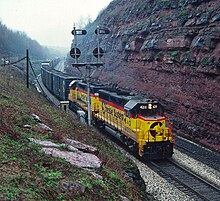| Revision as of 20:50, 3 November 2015 editColin Douglas Howell (talk | contribs)Extended confirmed users5,945 edits Wikilink horseshoe curve.← Previous edit | Revision as of 03:53, 2 April 2016 edit undoDthomsen8 (talk | contribs)Autopatrolled, Extended confirmed users, Pending changes reviewers, Rollbackers498,600 edits Filling in 4 references using ReflinksNext edit → | ||
| Line 1: | Line 1: | ||
| ]) ] enters the Sand Patch Tunnel eastbound in 1987.]] | ]) ] enters the Sand Patch Tunnel eastbound in 1987.]] | ||
| '''Sand Patch Grade''' is an approximately {{Convert|100|mi|km|adj=mid|-long}} section of railroad track known for its steep ]s and curves through the ] of Pennsylvania and Maryland.<ref>http://www.ihavideo.com/HIedscorn1.html</ref> The line is part of the ], an East-West ] operated by ]. The line was originally built by the ] (B&O), which became a component of the ] in 1972, then was merged into CSX in 1987. A well-known landmark along Sand Patch Grade is the {{Convert|4,475|ft|m|adj=mid|-long}} Sand Patch Tunnel, which was constructed between 1854 and 1871. The original one-track tunnel was abandoned after a two-track tunnel was completed nearby in 1912.<ref>{{cite web |url=http://lcweb2.loc.gov/master/pnp/habshaer/pa/pa3200/pa3235/data/pa3235data.pdf |title=Sand Patch Tunnel |last=Brown |first=Scott C. |date=1992 |website=Historic American Engineering Record |publisher=Library of Congress |location=Washington, D.C. |page=1 |accessdate=January 29, 2014}}</ref> The tunnels used vertical ventilation shafts with fires in them to circulate air.{{Citation needed|date=May 2013}} The original tunnel was abandoned in 1917 and is now flooded and collapsed in places.<ref>http://www.steamphotos.com/Railroad-Photos/Abandoned-Railroad-Tunnels/3405984_hFJN7#201168208_Wj4CH</ref> Dropping over {{Convert|1,000|ft}} in about {{Convert|20|mi}}, Sand Patch Grade is one of the steepest railroad grades on the East Coast.<ref>http://www.meyersdalepa.org/railroad/sandpatch.html</ref> In 2001, the 'SA' Tower was decommissioned and demolished. ], along the Sand Patch Grade is a popular spot for ] and photographers due to the ] located there, as well as the scenic backdrop provided by the old general store and tree farm. Also to watch the trains struggle up the steep grade, which is as much as two percent.<ref>http://www.trainzproroutes.org/sandpatch.html</ref> | '''Sand Patch Grade''' is an approximately {{Convert|100|mi|km|adj=mid|-long}} section of railroad track known for its steep ]s and curves through the ] of Pennsylvania and Maryland.<ref>{{cite web|url=http://www.ihavideo.com/HIedscorn1.html |title=Welcome to The Sand Patch Guide at HIGH IRON Online |publisher=Ihavideo.com |date=2001-09-11 |accessdate=2016-04-02}}</ref> The line is part of the ], an East-West ] operated by ]. The line was originally built by the ] (B&O), which became a component of the ] in 1972, then was merged into CSX in 1987. A well-known landmark along Sand Patch Grade is the {{Convert|4,475|ft|m|adj=mid|-long}} Sand Patch Tunnel, which was constructed between 1854 and 1871. The original one-track tunnel was abandoned after a two-track tunnel was completed nearby in 1912.<ref>{{cite web |url=http://lcweb2.loc.gov/master/pnp/habshaer/pa/pa3200/pa3235/data/pa3235data.pdf |title=Sand Patch Tunnel |last=Brown |first=Scott C. |date=1992 |website=Historic American Engineering Record |publisher=Library of Congress |location=Washington, D.C. |page=1 |accessdate=January 29, 2014}}</ref> The tunnels used vertical ventilation shafts with fires in them to circulate air.{{Citation needed|date=May 2013}} The original tunnel was abandoned in 1917 and is now flooded and collapsed in places.<ref>{{cite web|url=http://www.steamphotos.com/Railroad-Photos/Abandoned-Railroad-Tunnels/3405984_hFJN7#201168208_Wj4CH |title=Abandoned Railroad Tunnels |publisher=SteamPhotos.com |date= |accessdate=2016-04-02}}</ref> Dropping over {{Convert|1,000|ft}} in about {{Convert|20|mi}}, Sand Patch Grade is one of the steepest railroad grades on the East Coast.<ref>{{dead link|date=April 2016}}</ref> In 2001, the 'SA' Tower was decommissioned and demolished. ], along the Sand Patch Grade is a popular spot for ] and photographers due to the ] located there, as well as the scenic backdrop provided by the old general store and tree farm. Also to watch the trains struggle up the steep grade, which is as much as two percent.<ref>{{cite web|url=http://www.trainzproroutes.org/sandpatch.html |title=Sandpatch |publisher=Trainz Pro Routes |date= |accessdate=2016-04-02}}</ref> | ||
| ==See also== | ==See also== | ||
Revision as of 03:53, 2 April 2016

Sand Patch Grade is an approximately 100-mile-long (160 km) section of railroad track known for its steep grades and curves through the Allegheny Mountains of Pennsylvania and Maryland. The line is part of the Keystone Subdivision, an East-West main line operated by CSX Transportation. The line was originally built by the Baltimore & Ohio Railroad (B&O), which became a component of the Chessie System in 1972, then was merged into CSX in 1987. A well-known landmark along Sand Patch Grade is the 4,475-foot-long (1,364 m) Sand Patch Tunnel, which was constructed between 1854 and 1871. The original one-track tunnel was abandoned after a two-track tunnel was completed nearby in 1912. The tunnels used vertical ventilation shafts with fires in them to circulate air. The original tunnel was abandoned in 1917 and is now flooded and collapsed in places. Dropping over 1,000 feet (300 m) in about 20 miles (32 km), Sand Patch Grade is one of the steepest railroad grades on the East Coast. In 2001, the 'SA' Tower was decommissioned and demolished. Mance, Pennsylvania, along the Sand Patch Grade is a popular spot for railfans and photographers due to the horseshoe curve located there, as well as the scenic backdrop provided by the old general store and tree farm. Also to watch the trains struggle up the steep grade, which is as much as two percent.
See also
References
- "Welcome to The Sand Patch Guide at HIGH IRON Online". Ihavideo.com. 2001-09-11. Retrieved 2016-04-02.
- Brown, Scott C. (1992). "Sand Patch Tunnel" (PDF). Historic American Engineering Record. Washington, D.C.: Library of Congress. p. 1. Retrieved January 29, 2014.
- "Abandoned Railroad Tunnels". SteamPhotos.com. Retrieved 2016-04-02.
- "Sandpatch". Trainz Pro Routes. Retrieved 2016-04-02.
External links
- Historic American Engineering Record (HAER) No. PA-375, "Sand Patch Tunnel"